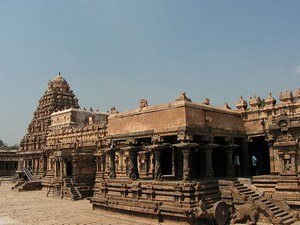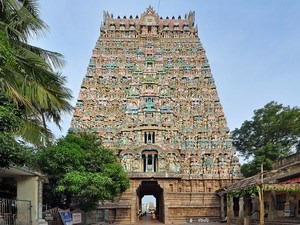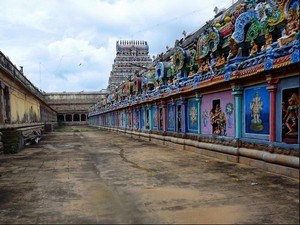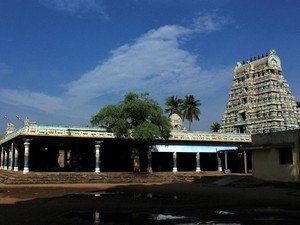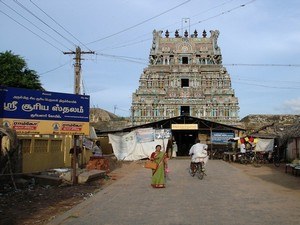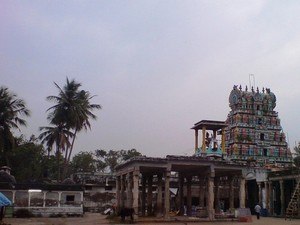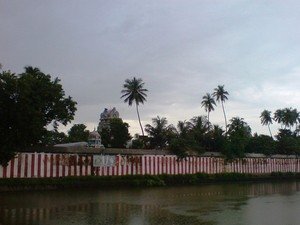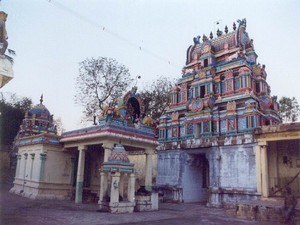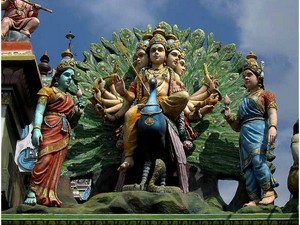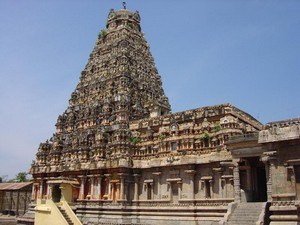Thirunageswaram Temple / Rahu Temple, Kumbakonam - Timings, Festivals, History, Darshan, Pooja Timings
Photo Credit: Flickr
 India | TamilNadu | Kumbakonam
India | TamilNadu | Kumbakonam
 #12 of 30 Places to Visit in Kumbakonam
#12 of 30 Places to Visit in Kumbakonam
 Distance (From Kumbakonam Railway Station): 5 Kms
Distance (From Kumbakonam Railway Station): 5 Kms
 Trip Duration (Including Travel): 30 Mins
Trip Duration (Including Travel): 30 Mins
 Place Location: At Thirunageswaram
Place Location: At Thirunageswaram
 Transportation Options: Walk/Trek
Transportation Options: Walk/Trek
 Travel Tips: None
Travel Tips: None
About Thirunageswaram Temple
At a distance of 5 Km from Kumbakonam Railway Station, Sri Naganathaswamy Temple or Rahu Sthalam is an ancient Hindu temple situated at Thirunageswaram, a village in the outskirts of Kumbakonam. Dedicated to Lord Shiva, it is one of the most prominent pilgrimage sites near Trichy. It holds particular importance within the Saivism sect of Hinduism as one of the Navagraha Stalas, which are temples linked to the nine planetary deities, specifically Rahu. The main deity is celebrated in the 7th-century Tamil Saiva text, the Tevaram, composed by the Tamil saint poets known as the nayanars, and is recognized as a Paadal Petra Sthalam.
History of Thirunageswaram Temple
Also known as Thirunageswaram Naganathar Temple, the tempe is thought to have been constructed by Aditya Chola I in the 10th century AD. Subsequent rulers have made their own enhancements to the temple. The inner mantapa was established by Seikkizhar, while the outer mantapa was created by Govinda Dikshitar, who served as the minister under the Nayak rulers Achuthappa Nayak (1560-1614) and Raghunatha Nayak (1600-34). In 1929, renovation efforts on the western walls included the addition of artistic inscriptions.
Mythology of Thirunageswaram Temple
Sri Naganathaswamy Temple is one of the 9 Navagraha Temples around Kumbakonam and is dedicated to Rahu. According to legend, the mythological serpents Adiseshan, Dakshan, and Kaarkotakan worshipped Lord Shiva at this site, which is how it acquired the name 'Tirunageswaram.' In another narrative, Indra was cursed by sage Gautama for his inappropriate behavior towards the sage's wife, Ahalya. To seek redemption from this curse, it is said that Indra worshipped Girigujambigai with a fragrant substance known as Punugu for duration of 45 days. Notable sages such as Gautama and Parashara, along with kings like Bhagiratha and Nala, are also believed to have worshipped Naganathar at this sacred location.
Architecture of Thirunageswaram Temple
The Rahu Temple located in Thirunageswaram showcases a stunning Dravidian architectural style, characterized by its impressive gopurams (gateway towers), elaborately carved pillars, and spacious courtyards. The temple is encircled by robust fort-like walls, featuring four entry towers that lead to the outermost prakaram. Within the third praharam, a nandavanam (flower garden) can be found on the northern side. The eastern gateway is adorned with the Vinayaka temple, Balipeetam, and Nandeeswarar Mandapam. On the southern side, there is a water tank accompanied by four mandapas, all encompassed by a 100-pillar mandapam designed in a temple-car style, with artistic pillars embellishing every direction.
In the second prakaram, the Rahu shrine is situated in the South-West corner, where Sri Rahu Bagawan is depicted alongside his two consorts, Nagavalli and Nagakanni. A distinctive aspect of this temple is that Rahu Bhagawan is represented with a human face, unlike the typical serpent face seen in other depictions. It is believed that performing a milk abhishekam for Rahu during Rahu kalam can alleviate issues such as delays in marriage, childlessness, difficulties in married life, and the adverse effects of Kalasarpa Dhosha and Sarpa Dhosha. Notably, during the milk abhishekam, the milk poured over the idol turns blue, a phenomenon that is clearly observable.
The pathway leading to the main sanctum in the second praharam features a hall supported by hundreds of pillars, each adorned with exquisite carvings of yalis. Within the sanctum, Lord Shiva is worshipped in the form of a lingam as Naganatha Swamy. His consort, Goddess Parvati, is represented as Giri Gujambigai in a separate shrine. It is believed that Goddess Girigujambal worships Shiva here, alongside other deities such as Lakshmi, Saraswathi, Ganesha, Muruga, and Shasta. Maha Bhairava is thought to safeguard and assist the divine mother during her prayers. The Goddess is revered as Swayambu, manifesting in the form of Meru, which is the reason no abhishekam (ablution) is performed for her image.
Festivals of Thirunageswaram Temple
The Sri Naganathaswamy Temple in Thirunageswaram celebrates several festivals, including the Brahmotsavam, Kanda Shasti, Navarathri, and Rahu Peyarchi. The Brahmotsavam being the most prominent celebrated for ten days in the Tamil month of Karthigai (November/December). Rahu Peyarchi is another significant festival celebrated once every 1.5 years on the star when Rahu switches its planetary position from one raasi to the other.
Thirunageswaram Temple Dress Code & Other Restrictions
When planning a visit to the Thirunageswaram Temple, it is recommended to adhere to modest clothing that covers your upper arms and legs as a sign of respect. Men are encouraged to wear a dhoti or pajama paired with an upper garment, as well as formal trousers and shirts. Women may opt for a saree, half saree, or churidhars. It is advisable to refrain from wearing contemporary attire such as mini-skirts, low-waist jeans, shorts, and sleeveless tops while on the temple grounds.
Non-Hindus are welcome to explore the temple complex and appreciate its architectural beauty; however, access to the sanctum sanctorum may be restricted.
Thirunageswaram Temple Timings
Monday: 6 AM - 1 PM & 4 PM 8:30 PM
Tuesday: 6 AM - 1 PM & 4 PM 8:30 PM
Wednesday: 6 AM - 1 PM & 4 PM 8:30 PM
Thursday: 6 AM - 1 PM & 4 PM 8:30 PM
Friday: 6 AM - 1 PM & 4 PM 8:30 PM
Saturday: 6 AM - 1 PM & 4 PM 8:30 PM
Sunday: 6 AM - 1 PM & 4 PM 8:30 PM
Thirunageswaram Temple Entry Fee
General Entry is Free
Special Darshan available for Rs. 150 - Rs. 250
Best Time to Visit Thirunageswaram Temple
The ideal time to visit Rahu Temple in Thirunageswaram is during the winter months, particularly from October to March, when the weather is pleasant and temperatures are more moderate. For Thirunageswaram Temple, it is advisable to visit during auspicious periods such as Rahu Kalam, which occurs daily, as well as on significant festival days like Maha Shivaratri and Pradosham. It is believed that attending the temple during these times enhances the likelihood of favorable outcomes from prayers. Visitors are encouraged to avoid the hot summer months from April to June, as temperatures can reach up to 40°C, making outdoor activities quite uncomfortable. Furthermore, the monsoon season, which lasts from July to September, brings heavy rainfall that may disrupt travel plans.
How to Reach Thirunageswaram Temple
Trichy Airport is the nearest airport, situated about 95 kilometers from Kumbakonam. The Kumbakonam Railway Station provides comprehensive train services to numerous cities, including Chennai, Rameshwaram, Kanyakumari, Pondicherry, Mysore, Mayiladuthurai, Thanjavur, Trichy, Bhubaneswar, Madurai, Coimbatore, Tirupati, Bangalore, and Thirunelveli. Furthermore, bus services connect Kumbakonam with all parts of Tamil Nadu. Travelers can utilize bus services or opt for a cab or auto-rickshaw to reach Thirunageswaram Naganathar Temple from Kumbakonam which is about 5 Km away.





